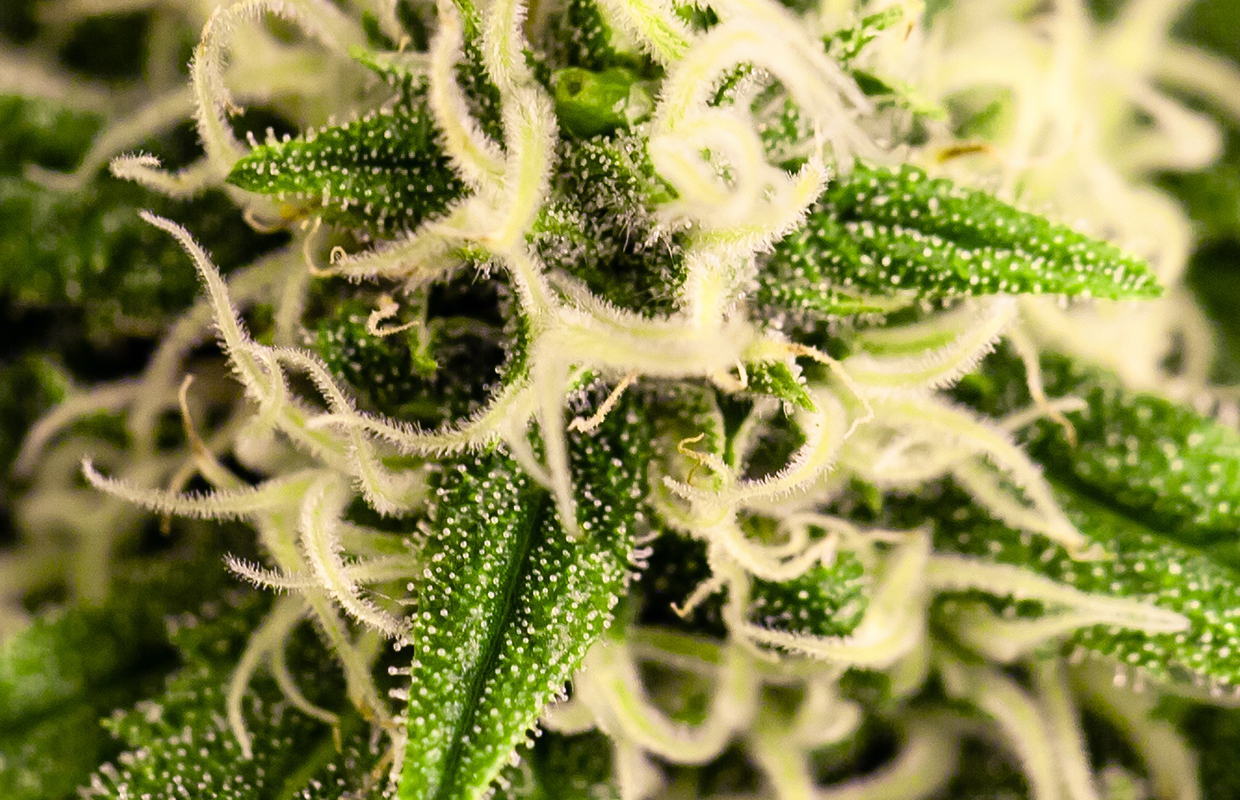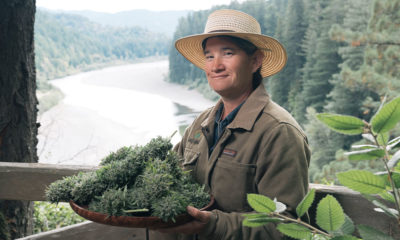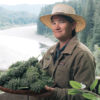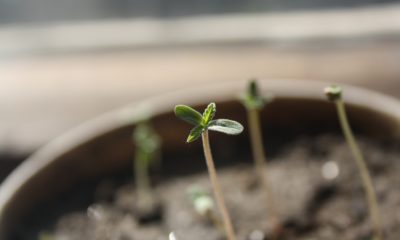Wrestling With Unstable Genetics
Cultivator Noah Sweeters reveals his systems for propagating hearty genetics.
Cultivator Noah Sweeters is crouched and inspecting the base of a marijuana plant that’s a few days from flowering. The sprawling grow space in San Jose, California is pegged at a comfortable 78 degrees through a squadron of superheated 1,000-watt lamps buzz overhead. Through a canopy of more than 1,000 vibrant plants the cultivator looks like Livingstone pressing his way through the thicket toward Lake Tanganyika. His hands are floating under and over the leaves in search of the right stem with the precise characteristics he requires to make the cut. When Sweeters finds a suitable specimen, there’s an audible slice and it’s into the water cup by his side and then on to the next stem.
So goes one of the systems for propagating hearty genetics – a widely used practice of taking cuttings for the purpose of cloning – intended to carry on the best in breed of chosen plant traits from a given garden.
“I’ve grown this Jack Herer for over 10 years now using cuttings like these,” says Sweeters, head cultivator at Airfield Supply Company in San Jose. “It is bar none our bestseller and the most reliable sativa genetics in this room. People absolutely love it.”
Originally making his mark as a cannabis grower producing that classic Jack, Sweeters has since parlayed his knowledge of cultivation into a full-time general manager position at the new Airfield facility and has expanded the collective’s menu to meet the ever-maturing tastes of the public. Primarily tasked with acquiring and sourcing good, potent medicine for the collective, he has also had a hand in developing new genetics.
One of Sweeters’ more notable creations to date – which he developed with his brother Nate and calls “Sweets” after its undeniably unique, sweet flavor and aromatic quality – is a blend of Jack Herer and Afghan Kush. Regularly testing out from 26-28 percent THC, the flavors are exquisite and highly sought after by customers.

“When considering developing a new strain, we quickly discovered how beautiful and unique our new Afghan addition was,” says Sweeters. “We also discovered that the clone we had acquired was unstable and had a high probability of self-pollinating.”
When stressed out during the indoor grow process, that Afghan Kush plant had a tendency to flip its gender by self-pollinating and becoming a hermaphroditic plant. As only female plants have the ability to produce flowers – or the “buds” that are the main product of the marijuana plant – whole crops would be decimated in the process of that change.
Unlike his trusted Jack, which was originally obtained from the reputable Sensi cannabis seed bank, and perpetuated through his repeated cloning process, the Sweets was produced by crossing that dependable Jack plant with his temperamental Afghan plant. The resulting seed harvest was then used to create the strain.
Sweeters had a dilemma on his hands, however – he knew that he had an exceptional specimen in the Afghan plant but he also knew how unstable those genetics could be in the best of circumstances, much less when confronted by stress from issues like excess heat or failure of lighting timers, as well as “light leak” into his grow rooms.
Stresses in grow rooms are often unavoidable conditions of the trade. Any number of things can go wrong. High-pressure sodium lights used for indoor cannabis production – which are designed to mimic the sun’s intense rays – produce a great amount of concentrated light and massive heat. The need to cool rooms is a perpetual battle that cannabis growers face. When AC units or circulating fans fail, rooms get hot and plants become stifled and suffer. A similar stressing occurs with light leaking into a grow room during nighttime hours. Flowering plants require a 12-hour-on/12-hour-off schedule of light to darkness. If even the smallest sliver of light steadily penetrates a room or the light period suddenly increases unknowingly during the 12 hours of darkness, a plant may become confused, stressed and ultimately lead to destabilization.
“The Afghani Kush had a lot of potential,” says Sweeters. “So we didn’t want to get rid of it because there was definitely the possibility of crossing it and utilizing that parent plant to make other strains with unique characteristics. But having unstable genetics and self-pollinating plants in your flowering garden will eventually pose a giant problem if breeding is not of your intentions.”
Though it would be an arduous task to stabilize his new creation, he couldn’t see throwing out the baby with the bath water and decided to forge onward to create a new strain. He’d just need to narrow down the right plants to cross.
Worth the Trip
Not unlike the microbrew phenomenon that first transformed the sedate taste buds of Miller Lite beer drinkers across the U.S., boutique cannabis cultivation has had a major influence in elevating the palates of today’s cannabis enthusiasts. High-end craft strains like the Sweets now account for a rapidly expanding trend in the marijuana marketplace and the ushering in of a golden age of top-shelf cannabis to match those maturing consumer palates.
Perry and Jennie Ammons say they know exactly what they want from their cannabis experience. On a recent sunny Saturday morning, the couple are making their way 120 miles down a stretch of Highway 80 from their house in Sacramento to San Jose. The Ammons take that familiar drive south every month, they say, to purchase medicine from their favorite source at the Airfield dispensary.
“It’s become sort of like going on a Costco run for us,” says Perry Ammons, 42, sharing why he and his wife happily drive over 100 miles for good, reliable marijuana. “Generally around the middle of each month we load the dog in the car and head south to the Bay for a pick up.”
The Ammons, who two years ago moved from San Jose to Sacramento for a new job that Perry took at an architect’s firm, describes why he and his wife go out of their way to get quality smoke.
“It’s like going to your favorite barber or pub,” says Perry, who first visited the San Jose collective three years ago. “They just do it right there, and you think, why go anywhere else and possibly get an inferior product or experience.”
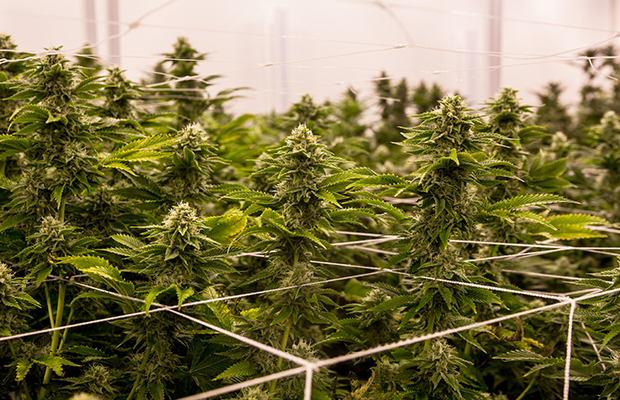
For the Ammons, nothing compares to the Sweets. Perry’s eyes go starry as he describes the flavors of the strain. “There’s a citrusy bite from the Jack’s lemon-cleaner scent.” An earthy “comfort-food quality like Italian wedding soup.”
“And there’s that awesome nectary tang that reminds me of Southern sweet tea,” says Jennie, who adds that the effects are just as good as the flavors. “The clarity I feel when I smoke Sweets is off the charts. You know, people have their favorite go-to drinks and food at restaurants and stuff – we have our favorite smoke. It just is the best.”
Sweeters identifies what that dominant taste is that people love in the Sweets strain. In fact, it was the impetus in many ways for creating the Jack-Afghan cross.
“These days the big seller is kush – OG Kush, Master Kush – it’s kush, kush, kush. There are so many,” he says. “So we knew if we took the characteristics of that great Jack heritage, which yields well and smells great and people enjoy, and blended it with our sweet Afghan Kush, then we’d probably have a winner.”
However, it didn’t happen overnight. The crossing took time to get that temperamental Afghan-Jack to cross right. He first tried crossing the plant with a CBD-rich Harlequin, as well as Royal Kush, but the results were not what he was looking for.
“When we got the seed harvest from the cross, we would go through plant by plant and look at the finished flower to see if they had the structure, aroma, yield, potency and the intermodal growth spacing we wanted,” says Sweeters. “So we selected seeds for those particular plants that showed the strongest flower characteristics.”
And eventually, through months of trial and error, the remarkable Sweets was born.
Proof of Pedigree
As the marijuana market continues to expand and make technological leaps forward, customers are becoming more and more accustomed to buying refined products and are demanding satisfaction guarantees from retailers. Gone are the days of customers accepting an inferior bag of schwag or a bunk sack of random seeds. Cannabis companies are now held to a higher standard and are required to stand behind their products to remain competitive and thrive in the marketplace.
Sweeters acknowledges that his method for creating the Sweets strain is not the more methodical process that a seed breeder or genetics company would take to produce seeds in a lab setting. But he also points out that many seed breeders do not stand behind the quality of their seeds, making it necessary to find ways to create strains in-house.
“Companies are not doing their due diligence. We buy seeds a lot in Santa Cruz and every single seed is completely different from the previous one that we popped,” he says. “Some breeders are not doing a good job of narrowing down the genetics. So many – Northern Lights, Silver Haze, Pink Lotus, the list goes on and on – are unstable and inconsistent.”
Eventually, science and technology will have to catch up with the cannabis industry. Genetic testing companies and labs dealing specifically with cannabis are already entering the marijuana game with greater frequency and helping to nail down which products are authentic and which are counterfeits or unreliable.
“It’s like buying a dog,” says Sweeters. “With a pedigree you get paperwork proving it’s a pure breed. Someone can tell you they have a pure breed, but without American Kennel Club papers is it really true? It’s the same with cannabis.”
While the testing of cannabis is a fairly new concept – currently most labs test at a minimum for molds, pesticides and potency levels – it’s likely that genetic testing for cannabis will become standard operating procedure in the future. Once that happens, it’ll be full-disclosure for customers regarding what they’re buying.
For now, people like the Ammons and their 120-mile shopping trip for great cannabis are emblematic of consumer needs and trust.
“We will gladly go out of our way and travel for good, consistent product,” says Jennie. “Good medicine really does speak for itself.”
Originally published in issue 20 in Cannabis Now. LEARN MORE.



